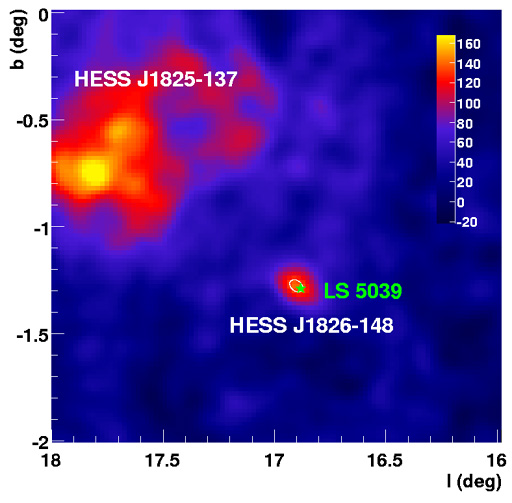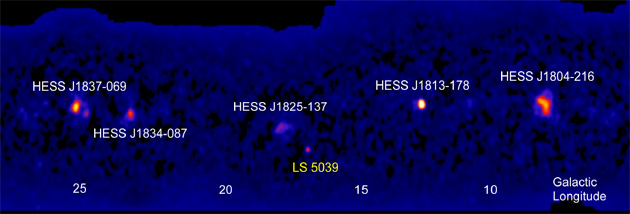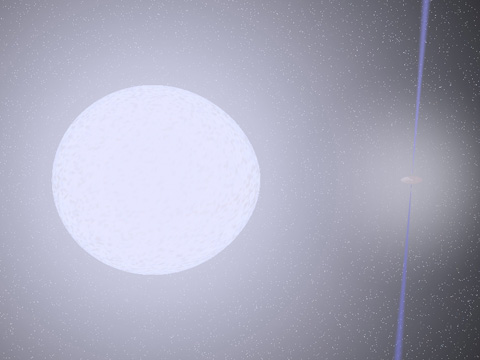|
Mystery compact object producing high energy radiation
In a recent issue of
Science Magazine, the High Energy Stereoscopic System
(H.E.S.S.) team of international astrophysicists report
the discovery of another new
type of very high energy (VHE) gamma ray source (Fig. 1,
Fig. 2).
Gamma-rays are produced in extreme
cosmic particle accelerators such as
supernova explosions and provide a unique view of the high energy processes at
work in the Milky Way. VHE gamma-ray astronomy is still a young field and H.E.S.S.
is conducting the first sensitive survey at this energy range, finding previously
unknown sources. The object that is producing the high energy
radiation is thought to be a
'microquasar'. These objects consist of two stars in orbit around each other (Fig.
3). One star
is an ordinary star, but the other has used up all its nuclear fuel, leaving behind a
compact corpse. Depending on the mass of the star that produced it, this compact
object is either a neutron star or a black hole, but either way its strong gravitational
pull draws in matter from its companion star. This matter spirals down towards the neutron
star or the black hole, in a similar way to water spiralling down a plughole. However, sometimes the compact object
receives more matter than it can cope with.
The material is then squirted away from the system in a jet of matter moving at
speeds close to that of light, resulting in a microquasar. The term microquasar
was chosen because these systems resemble the giant active galaxies -
quasars - with billion-solar-mass black holes at there center, except that
here the compact object weighs only a few solar masses and that the object is
in our Milky Way, rather than billions of light years away. Only a few such objects are
known to exist in our galaxy and one of them, an object called LS5039, has now
been detected by the H.E.S.S. team
(Fig.
1, Fig. 2).
In fact, the real nature LS5039 is a bit of a mystery.
It is not clear what the compact
object is. Some of the characteristics suggest it is a neutron star, some that it is a
black hole. Not only that, but the jet isn't much of a jet; although it is moving at about
20% of the speed of light, which seems a lot, in the context of these objects it's
actually quite slow.
Nor is it clear how the gamma rays are being produced.
As Dr. Guillaume Dubus of the Ecole Polytechnique points out "We really shouldn't have detected
this object. Very high energy gamma rays emitted close to the companion star are more likely to be
absorbed, creating a matter/antimatter cascade, than escape from the system."
Dr. Paula Chadwick of the University of Durham adds
"It's very exciting to have added another class of object to the growing catalogue of gamma ray
sources. It's an intriguing object – it will take more observations to work out what is going on in
there."
The H.E.S.S. array is ideal for finding new VHE
gamma ray objects, because its wide field of view (ten times the diameter of the Moon) means that it
can survey the sky and discover previously unknown sources. Dr. Stefan Funk from
the Max Planck Institute for Nuclear Physics: "The data from the H.E.S.S. sky survey, in
which LS5039 was discovered, are certainly good for further surprises!"
The
results were obtained using the High Energy Stereoscopic System
(H.E.S.S.) telescopes in Namibia, in South-West Africa. This system of
four 13 m diameter telescopes is currently the most sensitive detector
of very high energy gamma-rays, radiation a million million times more
energetic than the visible light. These high energy gamma rays are
quite rare –
even for relatively strong sources, only about one gamma ray per month
hits a square meter at the top of the earth's atmosphere. However,
since they are absorbed in the atmosphere, a direct detection of a
significant number of the rare gamma rays would require a satellite of
huge size. The H.E.S.S. telescopes
employ a trick – they use the atmosphere as detector medium. When gamma
rays are absorbed in the air, they emit short flashes of blue light,
named Cherenkov light, lasting a few billionths of a second.
This light is collected by the H.E.S.S. telescopes with big mirrors and
extremely sensitive cameras and can be used to create images of
astronomical objects as they appear in gamma-rays.
The H.E.S.S.
telescopes represent a multi-year construction effort by an
international team of more than 100 scientists and engineers from
Germany, France, the UK, Ireland, the Czech Republic, Armenia, South
Africa and the host country Namibia. The instrument was inaugurated in
September 2004 by
the Namibian Prime Minister, Theo-Ben Gurirab, and its first data have
already resulted
in a number of important discoveries, including the first astronomical
image of a supernova shock wave at the highest gamma-ray energies.
Notes
for Editors
The
H.E.S.S. collaboration
The High Energy Stereoscopic System (H.E.S.S.) team consists
of
scientists from Germany, France, the UK, the Czech Republic,
Ireland, Armenia, South Africa and Namibia.
The
H.E.S.S. array
H.E.S.S. web pages with further information:
Over
the last few years, the H.E.S.S. collaboration have been
building a system of four telescopes in the Khomas Highland region
of Namibia, to study very-high-energy gamma rays from cosmic
particle accelerators. The telescopes, known as Cherenkov
telescopes, image the light created when high-energy cosmic gamma
rays are absorbed in the atmosphere, and have opened a new energy
domain for astronomy. The H.E.S.S. telescopes each feature
mirrors of area 107 square metres, and are equipped with highly
sensitive and very fast 960-pixel light detectors in the focal
planes. Construction of the telescope system started in 2001; the
fourth telescope was commissioned in December 2003. Observations
were being made even while the system was being built, first using
a single telescope, then with two and three telescopes. While only
the complete four-telescope system provides the full performance,
the first H.E.S.S. telescope alone was already superior to any of
the instruments operated previously in the southern hemisphere.
Contacts
Dr. Guillaume Dubus
Laboratoire Leprince-Ringuet CNRS/IN2P3
Ecole Polytechnique
91128 Palaiseau
FRANCE
Tel +33 1 69 33 31 47 (LLR Paris), +33 1 44 32 80 75 (IAP Paris)
Dr. Mathieu de Naurois
LPNHE - Laboratoire de Physique Nucléaire et de Hautes Energies
IN2P3 - CNRS - Universités Paris VI et Paris VII
4 Place Jussieu
Tour 33 - Rez de chaussée
75252 Paris Cedex 05
FRANCE
Tel +33 1 44 27 23 24
Dr. Paula Chadwick
Department of Physics
Durham University
Science Laboratories
South Road
Durham DH1 3LE
UK
Tel +44 191 334 3560
Dr. Stefan Funk
Max-Planck-Institut für Kernphysik
Postf. 103980
69029 Heidelberg
Germany
Tel +49 6221 516 274
Related
Images

(high resolution version)
Figure 1. Map of the gamma ray sky
in the region of the new gamma ray source LS5039, also termed HESS J1826-148. The green star shows the position of
LS5039 as measured using radio telescopes, and the white ellipse shows the gamma
ray
position. In the upper-left corner, another H.E.S.S.-discovered gamma ray source
is visible, called HESS J1825-137.

(high resolution version)
Figure 2. A larger picture of the gamma ray sky as measured with H.E.S.S. LS5039 was
discovered
during the first scan of the galactic plane ever made at very high energies.
Initial survey results were published in Science Magazine, see
corresponding press release.

(high resolution version)
Figure 3.
A computer simulation of the microquasar LS5039, showing one possible
scenario where gamma rays are generated in microquasar 'jets'. The companion star to the
compact
object is a massive star that is losing material from its surface. This matter
is then
captured by the compact object's strong gravitational field and spirals down
towards the
surface. Some of this material is then ejected in two jets traveling at 20% of
the speed of
light. This image was created using
software developed by Rob Hynes
(LSU). For another illustration of a microquasar, see
here.
|



